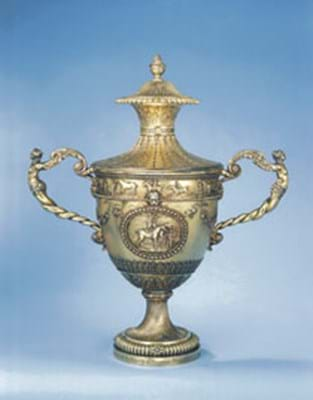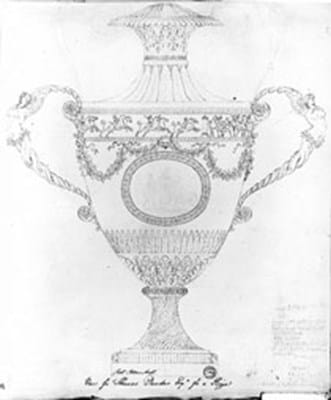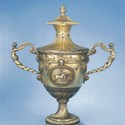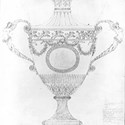Such a contest merited a rich prize and in 1763, when Aske Hall was sold for £45,000, the new owner Sir Lawrence Dundas (1712-1781) suggested his architect Robert Adam might design the winner's prize. He arranged for its execution in silver gilt by the London goldsmiths Daniel Smith and Robert Sharp.
Adam's original sketch for A Vase for Thomas Dundas Esq., for a Prize survives in the John Soanes Museum. Executed c.1763 in a newly fashionable style, it is perhaps the first directly attributable neoclassical design for a piece of silver.
It seems that the design was favoured as the annual prize up until 1770, so perhaps half a dozen of the deluxe 300 guinea cups were made. The first is hallmarked 1764 and - following its sale at auction in 1987 for £66,000 - now resides in the Museum of Fine Arts, Boston.
In 1767, the winner was Chatsworth, a pacy and durable runner (he placed second in 1768 and again in 1769). Chatsworth was a direct descendent of Gadolphin Arabian, one of the four bloodline stallions from which all thoroughbred racehorses descend.
The cup awarded to Peregrine Wentworth (1722-1809) of Toulston Lodge who co-owned the horse with Sir Lawrence Dundas. In his will, dated February 9, 1809, Wentworth wrote: To the Duke of Leeds my cup won many years ago at Richmond Races by my horse Chatsworth. It was the only item in his trophy cabinet he bequeathed by name.
This magnificent piece of George III silver gilt was the highlight of the silver sale conducted by Woolley & Wallis of Salisbury on October 19. It stands 183/4in (48cm) high and its combination of superb cast, engraved and chased decoration weighs in at 132oz.
It is inscribed around the rim Richmond 1767, Sir Henry Lawson Bart, Tennison Shafto Esq (stewards) and around the foot Won by Chatsworth, the property of Peregrine Wentworth Esq, beating Fortune Hemp, Mewburn, Beaufremont and Silvo.
As part of the so-called Fauconberg and Conyers heirlooms, it was making its first appearance on the market. This cache of family silver (the engraved crests and armorials were primarily those of the Dukes of Leeds and their relations) had been stored in banks and - judging by the copies of the Yorkshire Post of 1929 and the Morning Post of 1928 that provided wrapping - appeared to have last been examined at the time of the Depression.
It was the copy of the Yorkshire Post that sparked interest in the trophy in its native north. The Post, currently celebrating its 250th anniversary, was keen to carry the story about a masterpiece 'discovered' wrapped in its pages and one of its readers felt sufficiently passionate about the tale as to catch a train to Salisbury on the morning of sale day and attempt an act of repatriation.
Richmond in North Yorkshire has one of the earliest documented racecourses in England and played an important role in the rapid expansion in horseracing promoted by the monarchy between 1680 and 1740.
The Gold Cup almost made its way back to Richmond. The gentleman bid strongly above the £50,000-60,000 estimate but proved the underbidder against some smoke and mirrors bidding from the opposition at £90,000 (plus 15 per cent buyer's premium).
Winning the Richmond Cup again
The Richmond Gold Cup was one of the great Georgian flat races. Four miles, eight of the finest thoroughbreds of the day, and an ancient course set in the rolling Capability Brown parklands of Aske Hall.








